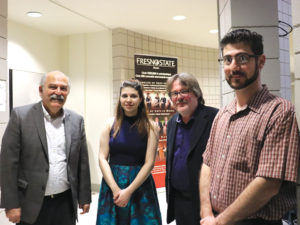
Photo: Andrew Hagopian
Yervand Boyajyan
Staff Writer
The month of February ended with an amazing and professional concert with pianist Nara Ave-tisyan. The Philip Lorenz In-ternational Keyboard Concerts and the Fresno State Armenian Studies Program presented the third and final musician in the “Young Armenian Talent” series, bringing joy to the audience with a memorable performance of various repertoires. The Concert was made possible through the generous support of the Thomas A. Kooyumjian Family Foundation.
Avetisyan opened her Friday, February 28 concert with Georg Händel’s popular “Suite in D minor.” This famous work pre-sents a challenge to all pianists with its six movements and technical passages. Händel’s compositions were influenced heavily by Italian Baroque and some German Choral music. He was a German and British composer, famously known for his work “Hallelujah.” His music has that element of surprise and occasional rapid passage. Avetisyan’s efforts to replicate such style did not go unnoticed. She was able to stay faithful to Händel’s interpretation and played the music wonderfully. Her selection of this specific composition portrayed both Ital-ian Baroque and German Choral styles.
The next piece was written by well-known 20th century Spanish composer, Enrique Granados. Avetisyan played “El Amor y la Muerte” (Love and Death) which is a ballad from the famous Goyescas Opera. Granados’ wri-ting is considered “romantic” and many pianists agree that due to the opera’s ornamentation, it is exceedingly difficult to master. The difficulty of the piece is also attributed to its challenging improvisational style. This style is most clear in “El Amor y la Muerte.” Avetisyan overcame the difficulty of the Spaniard’s composition and eloquently pieced together the ballad of “Love and Death.”
Before the intermission, Avetisyan performed a contem-porary sonata for piano entitled “Sonata” by Armenian composer Vago Zakaryan. This piece is fairly new, and Avetisyan intended to introduce its freshness to the Fresno audience. Even though an Armenian composer wrote the piece, it still lacked Armenian components. It did not sound like an Armenian composition, but that was not the intent of the composer. The last movement out of the three, “Allegro con Fuoco (Cheerful with Fire),” represented the style the composer was aiming for. It had the intended fast and unexpected runs with that fiery personality. Avetisyan truly gave an amazing performance capturing the essence of Zakaryan’s piano sonata.
The three unique pieces Nara Avetisyan performed were all challenging, musical, and breathtaking. Her reputation and years of schooling made it possible for her to perform such amazing works of art. Born in Yerevan, Armenia into an artistic family, Avetisyan began playing at the age of six, winning her first competition a year later. Avetisyan has since won numerous piano competitions all around the world. She has a double bachelor’s degree along with a double master’s degree from prestigious music schools and is currently working on her DMA, Doctor in Musical Arts, at Stony Brook University. She has also performed in a variety of groups and philharmonics from around the world and is considered one of the most talented young pianists of our generation.
After a short intermission, Avetisyan continued her concert with Robert Schumann’s “Kreis-leriana.” The piece is inspired by the writings of Ernst Theodor Wilhelm Hoffman. Hoffman was a Gothic and fantasy writer who portrayed his alter ego as a moody, asocial composer, Johannes Kreisler. This character inspired Schumann’s piece that was so beautifully played by Avetisyan. The composition consists of eight individual movements, each telling a story of Kreisler and his personality. The last movement, “Schnell and Spielend” (Fast and Playful), was by far the most breathtaking and expressive piece of the night. She was able to capture the spirit of the movement and to play it very musically.
Before Avetisyan concluded her wonderful evening full of joy and music, she performed Arno Babadjanian’s “Poem.”
This work was written expressly for a solo piano performance and is considered one of Babadjanian’s most beautiful pieces. The music is inspired by the Romantic style of the 19th century. Romantic music is considered individualistic, emotional, and dramatic. All of these characteristics are typical of poetry, which is exactly the style Babadjanian was aiming for when writing Poem in the 1960’s. Avetisyan did a magnificent job encapsulating the style of this music. Her professionalism and many years of experience was evident through her performance of Poem, along with her other performances of that evening.
 Hye Sharzhoom Armenian Action
Hye Sharzhoom Armenian Action